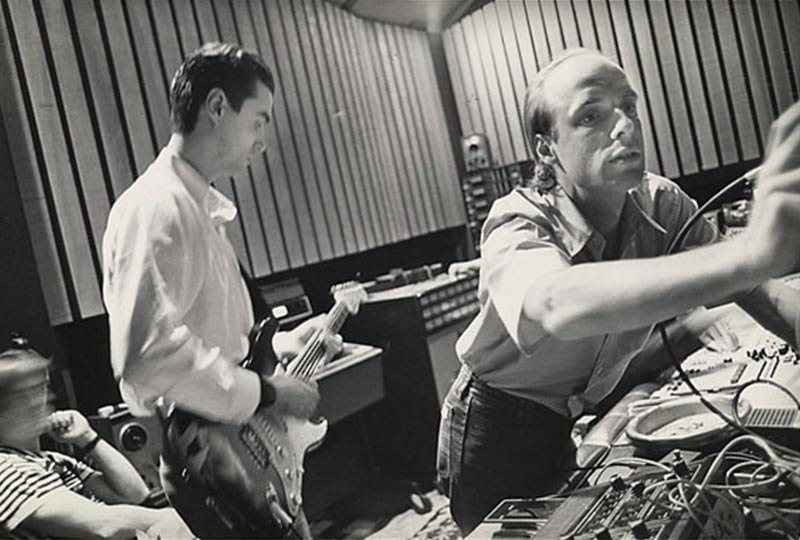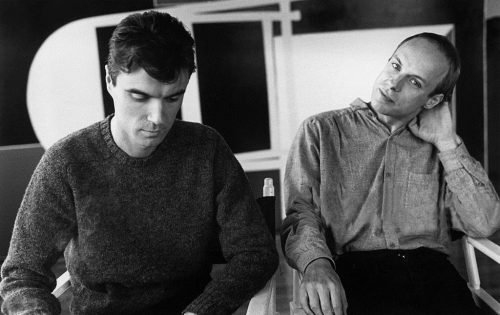In the late 1970s, a transformative partnership emerged between an avant-garde producer and an ambitious rock band, reshaping the landscape of popular music. As Talking Heads frontman David Byrne recalled, “Working with Brian was like discovering a new language.” This collaboration between Talking Heads and Brian Eno, which began in 1978, not only redefined the band’s sound but also pushed the boundaries of what rock music could be.
Brian Eno’s involvement with Talking Heads marked a pivotal moment in the band’s career, steering their music towards a more experimental and eclectic direction. Known for his pioneering work in ambient music and his innovative production techniques, Eno brought a fresh perspective that significantly influenced the band’s sonic palette. Through their partnership, Talking Heads ventured into uncharted musical territories, blending elements of funk, African rhythms, and electronic music with their post-punk roots.
Background of Talking Heads and Brian Eno

Before their groundbreaking collaboration with Brian Eno, Talking Heads had already begun to carve out a niche for themselves in the New York City music scene. Formed in 1975 by David Byrne, Chris Frantz, and Tina Weymouth, the band quickly became a fixture at the legendary CBGB club, sharing the stage with punk and new wave contemporaries like The Ramones and Blondie. Their debut album, “Talking Heads: 77,” released in 1977, captured the raw, angular energy of their live performances.
“Talking Heads: 77” showcased the band’s distinctive blend of art-punk and new wave, characterized by Byrne’s quirky, yelping vocals, Weymouth’s pulsating bass lines, and Frantz’s tight, minimalist drumming. The album’s lead single, “Psycho Killer,” became an instant classic, with its stark, paranoid lyrics and infectious groove. Early influences for the band included the Velvet Underground, The Modern Lovers, and a variety of African and world music, which hinted at the eclectic directions they would later explore. Their sound, while innovative, was still relatively straightforward and rooted in the post-punk ethos of the time.
Brian Eno’s Musical Philosophy
Brian Eno’s entry into the music world was as a member of the pioneering glam rock band Roxy Music, where he served as a synthesizer player and sound manipulator. However, Eno’s true genius lay in his post-Roxy Music career, where he became renowned for his work as a producer and his development of ambient music. Eno’s approach to music was deeply influenced by his belief in the studio as an instrument, an idea he explored extensively in his solo albums like “Here Come the Warm Jets” (1974) and “Another Green World” (1975).
Eno’s production philosophy centered on the concept of “oblique strategies,” a set of cards he co-created to help overcome creative blocks by introducing random prompts. This method encouraged spontaneity and unconventional thinking in the studio. Eno’s work with artists like David Bowie on his “Berlin Trilogy” and with bands such as Ultravox and Devo, showcased his ability to transform and elevate their sounds. His pioneering ambient works, including “Music for Airports” (1978), emphasized texture and atmosphere over traditional song structures, profoundly influencing the ambient and electronic genres.
The Beginning of the Collaboration

The seeds of the collaboration between Talking Heads and Brian Eno were sown in the bustling New York City music scene of the late 1970s. Talking Heads had garnered attention with their debut album, “Talking Heads: 77,” and were looking to expand their sound. Enter Brian Eno, who had already made a name for himself as a trailblazing producer and a key figure in the world of ambient music.
The introduction came through mutual admiration and shared connections. Eno, who was fascinated by the burgeoning punk and new wave scenes, attended a Talking Heads concert and was impressed by their unique approach and energy. The band, in turn, were admirers of Eno’s work with Roxy Music and his solo projects. Conversations between the band and Eno soon followed, where they discovered a mutual interest in pushing the boundaries of conventional rock music. Eno’s reputation for innovation and his willingness to experiment made him an ideal collaborator for the ambitious band. In 1978, they decided to join forces, marking the beginning of a partnership that would redefine their music.
First Collaboration – “More Songs About Buildings and Food”
Their first collaborative effort was the album “More Songs About Buildings and Food,” released in July 1978. This album marked a significant departure from the band’s debut, showcasing immediate changes in sound and production techniques that Eno brought to the table. The album’s title reflected the band’s characteristic wit and penchant for everyday topics, but the music within was anything but ordinary.
Notable Changes
One of the most notable changes was the album’s fuller, more textured sound. Eno’s influence was evident in the increased use of studio techniques and the integration of diverse musical elements. He encouraged the band to experiment with layered arrangements and to incorporate a variety of sounds, including African rhythms, funk grooves, and electronic textures. The result was a richer, more complex sonic landscape compared to the rawer sound of their debut.
Tracks like “Take Me to the River,” a cover of the Al Green classic, exemplified this new direction. The song featured a deep, groovy bass line, intricate guitar work, and atmospheric production that highlighted Eno’s knack for blending traditional rock instrumentation with innovative studio effects. Another standout track, “Found a Job,” combined driving rhythms with quirky, interlocking guitar lines, showcasing the band’s growing confidence and creativity under Eno’s guidance.
Eno’s production techniques also included the use of tape loops, unconventional recording methods, and his famous “oblique strategies” cards, which introduced elements of chance and spontaneity into the recording process. This approach not only broadened the band’s musical palette but also instilled a sense of adventurousness and unpredictability in their work.
“More Songs About Buildings and Food” received critical acclaim and laid the foundation for an even deeper collaboration on subsequent albums. It was clear from this first project that Eno’s innovative production and the band’s willingness to explore new musical territories were a perfect match, setting the stage for their future masterpieces.
Evolution of Sound Through Albums
“Fear of Music” (1979)

Innovations:
Released in August 1979, “Fear of Music” marked a significant step forward in Talking Heads’ musical evolution. With Brian Eno back at the helm, the band delved deeper into experimental territory, incorporating a range of innovative elements that set this album apart from its predecessors. One of the most striking features of “Fear of Music” was the introduction of African rhythms, which added a new layer of complexity and richness to the band’s sound. Tracks like “I Zimbra” exemplified this shift, featuring polyrhythmic percussion and a chant-like vocal delivery that drew inspiration from African music traditions.
In addition to these global influences, the album also showcased unconventional song structures and the use of ambient sounds, reflecting Eno’s signature production style. Songs like “Mind” and “Drugs” incorporated eerie, atmospheric textures, creating a sense of tension and unease that matched the album’s introspective and often dystopian themes. The use of ambient sounds and studio effects helped to blur the lines between traditional rock music and more avant-garde, experimental forms.
Critical Reception:
“Fear of Music” was met with widespread acclaim from critics and fans alike. It was praised for its bold experimentation and the band’s willingness to push the boundaries of their sound. Critics highlighted the album’s innovative use of rhythm and texture, as well as its dark, thought-provoking lyrics. The album solidified Talking Heads’ reputation as one of the most forward-thinking and creative bands of the era, setting the stage for even greater achievements to come.
“Remain in Light” (1980)

Concept and Execution:
“Remain in Light,” released in October 1980, represented the pinnacle of the Talking Heads-Brian Eno collaboration. This album saw the band and Eno fully embracing the fusion of funk, polyrhythms, and layered textures, creating a dense, intricate soundscape that was both innovative and captivating. The themes of “Remain in Light” revolved around concepts of identity, technology, and modernity, often conveyed through fragmented, stream-of-consciousness lyrics.
Eno’s influence was evident in the album’s complex arrangements and the extensive use of studio manipulation. The recording process involved looping and layering various instrumental and vocal tracks, creating a richly textured sonic tapestry. The band also drew heavily from African music, particularly in the use of interconnected guitar patterns and rhythmic structures that created a hypnotic, driving groove throughout the album.
Signature Tracks:
Key tracks like “Once in a Lifetime” and “The Great Curve” exemplified the innovative sound of “Remain in Light.” “Once in a Lifetime” became one of the band’s most iconic songs, with its infectious bassline, hauntingly repetitive lyrics, and Byrne’s distinctive vocal delivery. The song’s philosophical musings on the nature of existence resonated deeply with listeners, cementing its place in the pantheon of rock classics.
“The Great Curve” showcased the band’s mastery of polyrhythms and layered textures, with its rapid-fire guitar riffs, propulsive rhythms, and soaring vocal harmonies. The track was a testament to the seamless integration of diverse musical influences, resulting in a sound that was both cohesive and groundbreaking.
Impact:
“Remain in Light” had a profound impact on both Talking Heads and the broader music industry. The album’s innovative approach to rhythm, texture, and production techniques influenced a wide range of artists across various genres, from alternative rock to hip-hop. It also marked a peak in the band’s creative output, setting a new standard for what could be achieved through collaboration and experimentation in music.
Technical and Creative Processes

Brian Eno’s innovative approach to recording and production was instrumental in transforming Talking Heads’ sound. One of the key techniques he introduced was the use of looped tracks, a method he had perfected in his ambient music projects. By creating loops of rhythmic patterns, melodic fragments, and even entire instrumental sections, Eno was able to build complex, layered soundscapes that added depth and texture to the band’s music.
Another hallmark of Eno’s production style was his use of ambient soundscapes. He often incorporated environmental sounds, unconventional instruments, and electronic effects to create atmospheric backgrounds that enhanced the emotional and sonic impact of the songs. For instance, on “Fear of Music,” tracks like “Memories Can’t Wait” and “Drugs” featured eerie, otherworldly soundscapes that contributed to the album’s dark, introspective mood.
Studio experimentation was another key aspect of Eno’s technique. He encouraged the band to explore unconventional recording methods, such as using “oblique strategies” cards to introduce randomness and creativity into the process. This approach led to spontaneous and unexpected musical ideas, resulting in a more dynamic and innovative sound. Eno also employed advanced production techniques like tape manipulation, backwards recordings, and phased effects, further pushing the boundaries of traditional rock music.
Songwriting Evolution
The collaboration with Eno significantly influenced Talking Heads’ songwriting process. Prior to working with Eno, the band’s songwriting was relatively straightforward, with David Byrne typically taking the lead on lyrics and melodies. However, Eno’s involvement encouraged a more collaborative and experimental approach.
During this period, the band began to place greater emphasis on rhythm and texture, often building songs from improvised jams and rhythmic patterns rather than traditional chord progressions. This shift is evident in the creation of “Remain in Light,” where many of the tracks originated from extended jam sessions. Eno would record these sessions, then edit and loop sections to form the basis of the songs. This method allowed for a more organic and fluid development of ideas, resulting in complex, multi-layered compositions.
The collaborative dynamic between Byrne, Eno, and the rest of the band became more egalitarian, with each member contributing to the creative process. This collective approach not only diversified the band’s sound but also fostered a sense of unity and experimentation that was crucial to their artistic growth.
Instrumentation and Arrangements
Eno’s influence also extended to the instrumentation and arrangements on the albums he produced with Talking Heads. He encouraged the band to experiment with a wide range of instruments and sounds, expanding their musical palette beyond the traditional rock setup. This period saw the introduction of African percussion, synthesizers, and unconventional instruments like the marimba and kalimba.
On “Remain in Light,” the band embraced a polyrhythmic approach, incorporating multiple interlocking rhythms and intricate guitar patterns inspired by African music. The use of funk and electronic elements further enriched their sound, with songs featuring prominent bass lines, dynamic horn sections, and layered vocal harmonies. The incorporation of these diverse elements created a vibrant, eclectic sound that was both innovative and infectious.
Eno’s expertise in arrangement also played a crucial role. He meticulously crafted the layers of sound, ensuring that each element complemented the others to create a cohesive whole. This attention to detail is evident in tracks like “The Great Curve,” where the complex interplay of guitars, percussion, and vocals creates a mesmerizing, almost hypnotic effect.
Closing Thoughts

Throughout their collaboration with Brian Eno, Talking Heads underwent a profound transformation that redefined their sound and expanded their musical horizons. Starting with their initial meeting, Eno’s innovative production techniques and creative vision became instrumental in shaping the band’s evolution. From the introduction of African rhythms and ambient soundscapes in “More Songs About Buildings and Food” to the experimental textures and polyrhythmic complexities of “Fear of Music” and “Remain in Light,” each album showcased a distinct progression in their artistry.
The integration of looped tracks, atmospheric soundscapes, and studio experimentation brought a new level of depth and sophistication to their music. The band’s songwriting process evolved to become more collaborative and exploratory, resulting in richly layered compositions that pushed the boundaries of traditional rock. The diverse instrumentation and intricate arrangements further diversified their sound, cementing their place as pioneers in the post-punk and new wave movements.
A Seminal Moment
The collaboration between Talking Heads and Brian Eno was a seminal moment not just for the band, but for the broader musical landscape. Eno’s influence helped Talking Heads unlock new creative potentials, leading to some of the most innovative and influential albums of the late 20th century. This partnership exemplifies the transformative power of creative collaboration, where the merging of distinct artistic visions can result in groundbreaking work that transcends genres and eras.
For Talking Heads, the experience with Eno opened up a world of possibilities, enabling them to explore and integrate diverse musical influences into their sound. This period of intense creativity and experimentation not only defined their legacy but also left an indelible mark on the music industry, inspiring countless artists across different genres.
